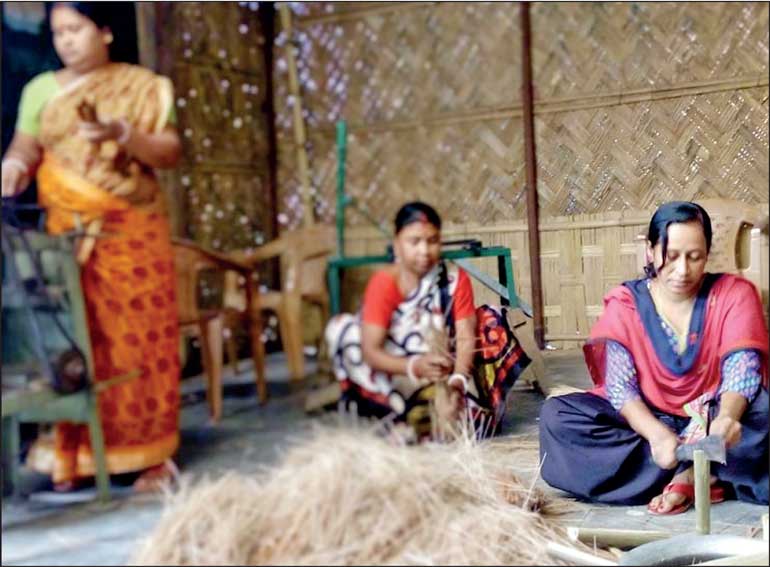Monday Dec 15, 2025
Monday Dec 15, 2025
Wednesday, 23 November 2022 00:00 - - {{hitsCtrl.values.hits}}

True Sri Lankan entrepreneurship will be weak unless we tackle the fundamental structural changes needed in our economy
 Sri Lanka just concluded celebrating Global Entrepreneurship Week 2022 (GEW), with many events, webinars and awareness sessions being held around the country. These celebrations of entrepreneurship are good, and perhaps a much-needed reprieve from the gloomy macroeconomic conditions. Yet, as GEW 2022 draws to a close, we shouldn’t allow ourselves to forget the fundamental structural flaws in the Sri Lankan economy that are holding entrepreneurship back. This article points to some of these aspects, with a view to setting priorities for 2023.
Sri Lanka just concluded celebrating Global Entrepreneurship Week 2022 (GEW), with many events, webinars and awareness sessions being held around the country. These celebrations of entrepreneurship are good, and perhaps a much-needed reprieve from the gloomy macroeconomic conditions. Yet, as GEW 2022 draws to a close, we shouldn’t allow ourselves to forget the fundamental structural flaws in the Sri Lankan economy that are holding entrepreneurship back. This article points to some of these aspects, with a view to setting priorities for 2023.
Sri Lanka’s domestic market is just 22 million, of which the consumer class and middle class is a fraction of it. So, to make any meaningful money as an entrepreneur you have to look not just at the Sri Lankan market but look outward. But our economy has increasingly become inward-looking. Moreover, the policy-orientation has skewed towards protectionism, crony-capitalism, and ‘tenderpreneurship’ rather than true entrepreneurship.
True entrepreneurs hurt by a heavy state and protectionism
The problematic growth model followed since 2005 enlarged the role of the state in Sri Lanka. The narrative that the state must play a larger role in the economy became more pronounced post-war. That growth model featured a public sector spending spree, including ‘debt for dud projects’, which is now hurting entrepreneurs by way of a sovereign default, high interest rates, a collapsed currency, and high inflation. It also featured private sector capital reallocation towards the public sector (crowding out private sector credit), and an emergence of businesses that chased government contracts (with banks happier to lend to those projects seen ‘safely’ covered by Treasury guarantees than to ‘riskier’ startups and new exporter entrepreneurs). Post-war GDP was driven, in no small part, by the construction and real estate sectors, and domestic non-tradable sectors that benefited from trade protection.
The Sri Lankan tariff schedule came to include many border taxes in addition to the standard customs duty, called ‘para-tariffs’. The total nominal protection rate (customs duty plus para-tariff) more than doubled (13.4% to 27.9%) between 2004 and 2009 (Pursell & Ahsan, 2011). By 2015 the average effective rate of protection for manufacturing production had increased from 47% in 2000 to 63%, and production for the domestic market was over 70% more profitable compared to production for exporting (World Bank, 2005; DCS, 2018). While around 57% of tariff lines are exempt from customs import duty, more than 66% of tariff lines attract PAL and 21% attract CESS - both of which are para-tariffs. This trade policy stance began to intertwine with revenue dependence. Revenue from trade taxes rose to 25% of total revenue, which was as high as it was prior to the 1990s second wave of reforms.
This then shaped the orientation of the economy and structure of output. Sri Lanka’s trade-to-GDP ratio, at just 45%, is now at low levels not seen since the early 1970s. Our exports-to-GDP ratio has fallen from the post-reform wave highs of 35% in post-1977 and 40% in late 90s and early 2000s, to around 15% today. Sri Lankan entrepreneurs today are relying more and more on narrow domestic market opportunities, rather than engaging with global markets.
Tariff protections, afforded to domestic enterprises (who were not necessarily competitive), became a pervasive policy tool. A new cohort of businesses and businesspeople that benefited from tariff protection, emerged. In Budget speeches, if you ‘listened between the lines’, you would almost be able to ‘hear’ the specific company or companies that certain preferential regulations or para-tariff proposals would benefit.
So, to be an entrepreneur in Sri Lanka, your real skill increasingly was not in taking risks and converting financial and sweat equity to business profit, but in astutely navigating the government regulatory, tender, and border taxation maze. Business innovation wouldn’t be in product or process, but in “procedure”.
Entrepreneurs in the technology and tech-adjacent sectors are perhaps the only ones who bucked this trend, and were able to rely less on the state, but were still constrained by the lack of outward-orientation of the economy and hurt by the overall macro model.
Trimming taxpayer-funded ‘entrepreneurship agencies’
Alongside all of this, the footprint of state institutions grew, which is no longer tenable in the current precarious fiscal scenario. We have multiple taxpayer-funded agencies (or divisions within them) involved in enterprise-support or entrepreneurship development activities in some shape or form – the National Enterprise Development Authority, the Industrial Development Board, the Information Communication Technology Agency, the regional development division of the Export Development Board, and the Small Enterprise Development Division of the Ministry of Youth Affairs, to name a few. The NEDA, IDB and EDB collectively have hundreds of staff stationed in district offices across the country. This is in addition to the numerous Small Business Development Officers based out of District Secretariats across the country. We simply cannot afford this anymore.
In a high tax environment now, it is unconscionable to keep using taxes collected from entrepreneurs to pay bureaucrats who are ostensibly meant to be developing entrepreneurship, when they often have no meaningful experience with entrepreneurship themselves. The Treasury should drive the consolidation of the NEDA, IDB, and the Regional Development Division of the Export Development Board into one entity. The role of BDOs in DS’s should be discontinued. Development Officers (DOs) hired to these agencies should be let go (they are qualified undergraduates and should be reoriented to jobs in the private sector).
The merged entity should have a clear and unambiguous mandate to improve SMEs’ trade competitiveness. Amidst the current forex crisis, the focus of programs should be to foster more export-ready or near export-ready entrepreneurs, rather than conducting generic and ‘plain vanilla’ SME development activities. The officers’ roles should be to provide trade facilitation to help entrepreneurs achieve their goals.
Priority focus for 2023
Global Entrepreneurship Week is about celebrating entrepreneurship, which is good. But true Sri Lankan entrepreneurship will be weak unless we tackle the fundamental structural changes needed in our economy, some of which were discussed in this article.
State-led economic activity shaped too much of the growth narrative over the past 15 years. Rather than creating a fair and even playing field for more entrepreneurship to thrive everywhere, there were distinct efforts to create pockets of favoured entrepreneurs. Chambers, associations, and membership organisations celebrating entrepreneurship during GEW should also call out these bad practices, which hurt the overall entrepreneurship ecosystem and discourage true entrepreneurs.
Government agencies using up entrepreneurs’ tax money must be scaled down, streamlined, deliver far greater value for money, and be made accountable to demonstrate real impact. We must reverse the inward-looking industrial policy, the protectionist trade regime, and the rent-seeking business regulatory environment.
To truly unleash ideas and unshackle entrepreneurs, Sri Lanka must focus on these areas that fundamentally shape the operating environment for entrepreneurs, and not only focus on soft initiatives. Otherwise, we risk tinkering on the edges, and coming back for GEW 2023 with much of the same problems that we have today.
(The writer is an economist, and Co-founder of the Centre for a Smart Future, an interdisciplinary public policy think tank. He was formerly Advisor to the Minister of Development Strategies and International Trade. He has served on the ‘Global Future Council on Innovation Ecosystems’ of the World Economic Forum, and on the boards of the National Enterprise Development Authority and Sri Lanka Export Development Board.)